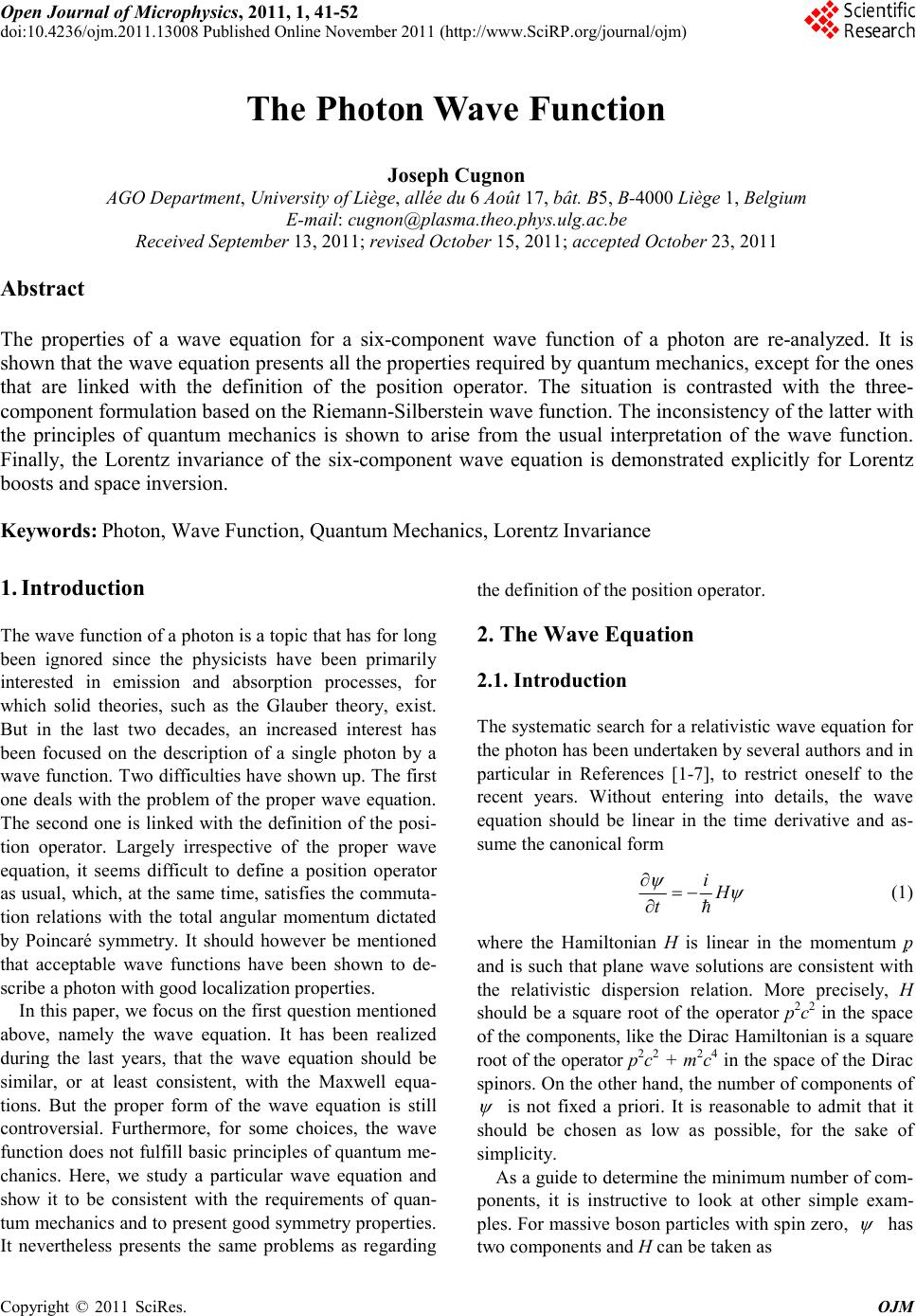 Open Journal of Microphysics, 2011, 1, 41-52 doi:10.4236/ojm.2011.13008 Published Online November 2011 (http://www.SciRP.org/journal/ojm) Copyright © 2011 SciRes. OJM The Photon Wave Function Joseph Cugnon AGO Department, University of Liège, allée du 6 Août 17, bât. B5, B-4000 Liège 1, Belgium E-mail: cugnon@plasma.theo.phys.ulg.ac.be Received September 13, 2011; revised October 15, 2011; accepted October 23, 2011 Abstract The properties of a wave equation for a six-component wave function of a photon are re-analyzed. It is shown that the wave equation presents all the properties required by quantum mechanics, except for the ones that are linked with the definition of the position operator. The situation is contrasted with the three- component formulation based on the Riemann-Silberstein wave function. The inconsistency of the latter with the principles of quantum mechanics is shown to arise from the usual interpretation of the wave function. Finally, the Lorentz invariance of the six-component wave equation is demonstrated explicitly for Lorentz boosts and space inversion. Keywords: Photon, Wave Function, Quantum Mechanics, Lorentz Invariance 1. Introduction The wave function of a photon is a topic that has for long been ignored since the physicists have been primarily interested in emission and absorption processes, for which solid theories, such as the Glauber theory, exist. But in the last two decades, an increased interest has been focused on the description of a single photon by a wave function. Two difficulties have shown up. The first one deals with the problem of the proper wave equation. The second one is linked with the definition of the posi- tion operator. Largely irrespective of the proper wave equation, it seems difficult to define a position operator as usual, which, at the same time, satisfies the commuta- tion relations with the total angular momentum dictated by Poincaré symmetry. It should however be mentioned that acceptable wave functions have been shown to de- scribe a photon with good localization properties. In this paper, we focus on the first question mentioned above, namely the wave equation. It has been realized during the last years, that the wave equation should be similar, or at least consistent, with the Maxwell equa- tions. But the proper form of the wave equation is still controversial. Furthermore, for some choices, the wave function does not fulfill basic principles of quantum me- chanics. Here, we study a particular wave equation and show it to be consistent with the requirements of quan- tum mechanics and to present good symmetry properties. It nevertheless presents the same problems as regarding the definition of the position operator. 2. The Wave Equation 2.1. Introduction The systematic search for a relativistic wave equation for the photon has been undertaken by several authors and in particular in References [1-7], to restrict oneself to the recent years. Without entering into details, the wave equation should be linear in the time derivative and as- sume the canonical form i t (1) where the Hamiltonian H is linear in the momentum p and is such that plane wave solutions are consistent with the relativistic dispersion relation. More precisely, H should be a square root of the operator p2c2 in the space of the components, like the Dirac Hamiltonian is a square root of the operator p2c2 + m2c4 in the space of the Dirac spinors. On the other hand, the number of components of is not fixed a priori. It is reasonable to admit that it should be chosen as low as possible, for the sake of simplicity. As a guide to determine the minimum number of com- ponents, it is instructive to look at other simple exam- ples. For massive boson particles with spin zero, has two components and H can be taken as 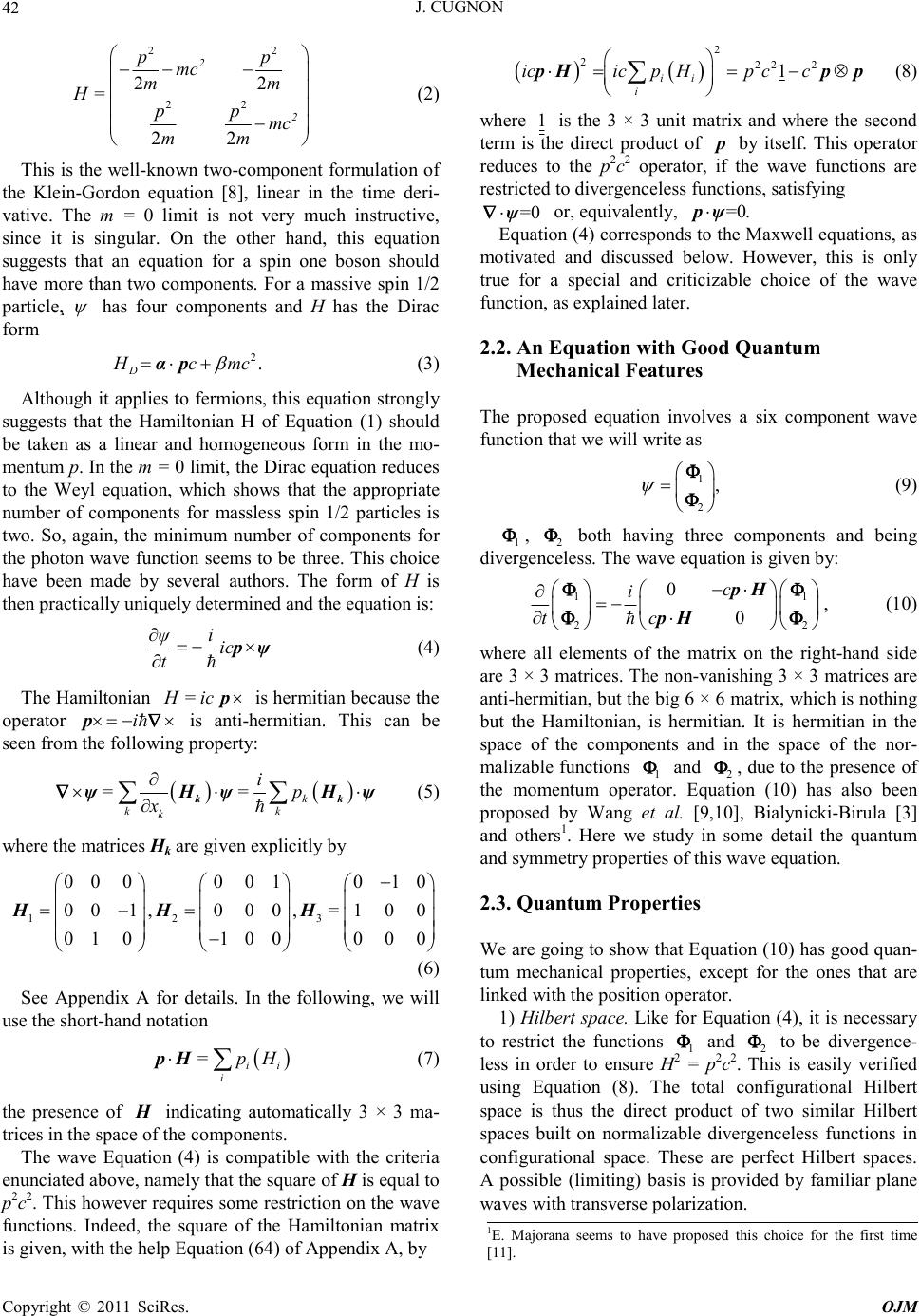 J. CUGNON 42 22 22 2 22 2 2 pp mc m H= pp mc mm 2m (2) This is the well-known two-component formulation of the Klein-Gordon equation [8], linear in the time deri- vative. The m = 0 limit is not very much instructive, since it is singular. On the other hand, this equation suggests that an equation for a spin one boson should have more than two components. For a massive spin 1/2 particle, has four components and H has the Dirac form 2. D cmc αp (3) Although it applies to fermions, this equation strongly suggests that the Hamiltonian H of Equation (1) should be taken as a linear and homogeneous form in the mo- mentum p. In the m = 0 limit, the Dirac equation reduces to the Weyl equation, which shows that the appropriate number of components for massless spin 1/2 particles is two. So, again, the minimum number of components for the photon wave function seems to be three. This choice have been made by several authors. The form of H is then practically uniquely determined and the equation is: ψiic t pψ (4) The Hamiltonian =ic is hermitian because the operator is anti-hermitian. This can be seen from the following property: ip k kk k i ==p x kk ψHψHψ (5) where the matrices Hk are given explicitly by 123 00 00 01010 00 1,000,100 01 010000 0 = HHH (6) See Appendix A for details. In the following, we will use the short-hand notation ii i =pH pH (7) the presence of indicating automatically 3 × 3 ma- trices in the space of the components. H The wave Equation (4) is compatible with the criteria enunciated above, namely that the square of H is equal to p2c2. This however requires some restriction on the wave functions. Indeed, the square of the Hamiltonian matrix is given, with the help Equation (64) of Appendix A, by 2 222 2 1 ii i icicpHpcc Hpp (8) where 1 is the 3 × 3 unit matrix and where the second term is the direct product of by itself. This operator reduces to the p2c2 operator, if the wave functions are restricted to divergenceless functions, satisfying =0 ψ or, equivalently, =ψ0.p Equation (4) corresponds to the Maxwell equations, as motivated and discussed below. However, this is only true for a special and criticizable choice of the wave function, as explained later. 2.2. An Equation with Good Quantum Mechan i cal Featu re s The proposed equation involves a six component wave function that we will write as 1 2 , (9) 1 , 2 both having three components and being divergenceless. The wave equation is given by: 11 22 0 0 c i c t pH pH , (10) where all elements of the matrix on the right-hand side are 3 × 3 matrices. The non-vanishing 3 × 3 matrices are anti-hermitian, but the big 6 × 6 matrix, which is nothing but the Hamiltonian, is hermitian. It is hermitian in the space of the components and in the space of the nor- malizable functions 1 and 2, due to the presence of the momentum operator. Equation (10) has also been proposed by Wang et al. [9,10], Bialynicki-Birula [3] and others1. Here we study in some detail the quantum and symmetry properties of this wave equation. 2.3. Quantum Properties We are going to show that Equation (10) has good quan- tum mechanical properties, except for the ones that are linked with the position operator. 1) Hilbert space. Like for Equation (4), it is necessary to restrict the functions 1 and 2 to be divergence- less in order to ensure H2 = p2c2. This is easily verified using Equation (8). The total configurational Hilbert space is thus the direct product of two similar Hilbert spaces built on normalizable divergenceless functions in configurational space. These are perfect Hilbert spaces. A possible (limiting) basis is provided by familiar plane waves with transverse polarization. 1E. Majorana seems to have proposed this choice for the first time [11]. Copyright © 2011 SciRes. OJM 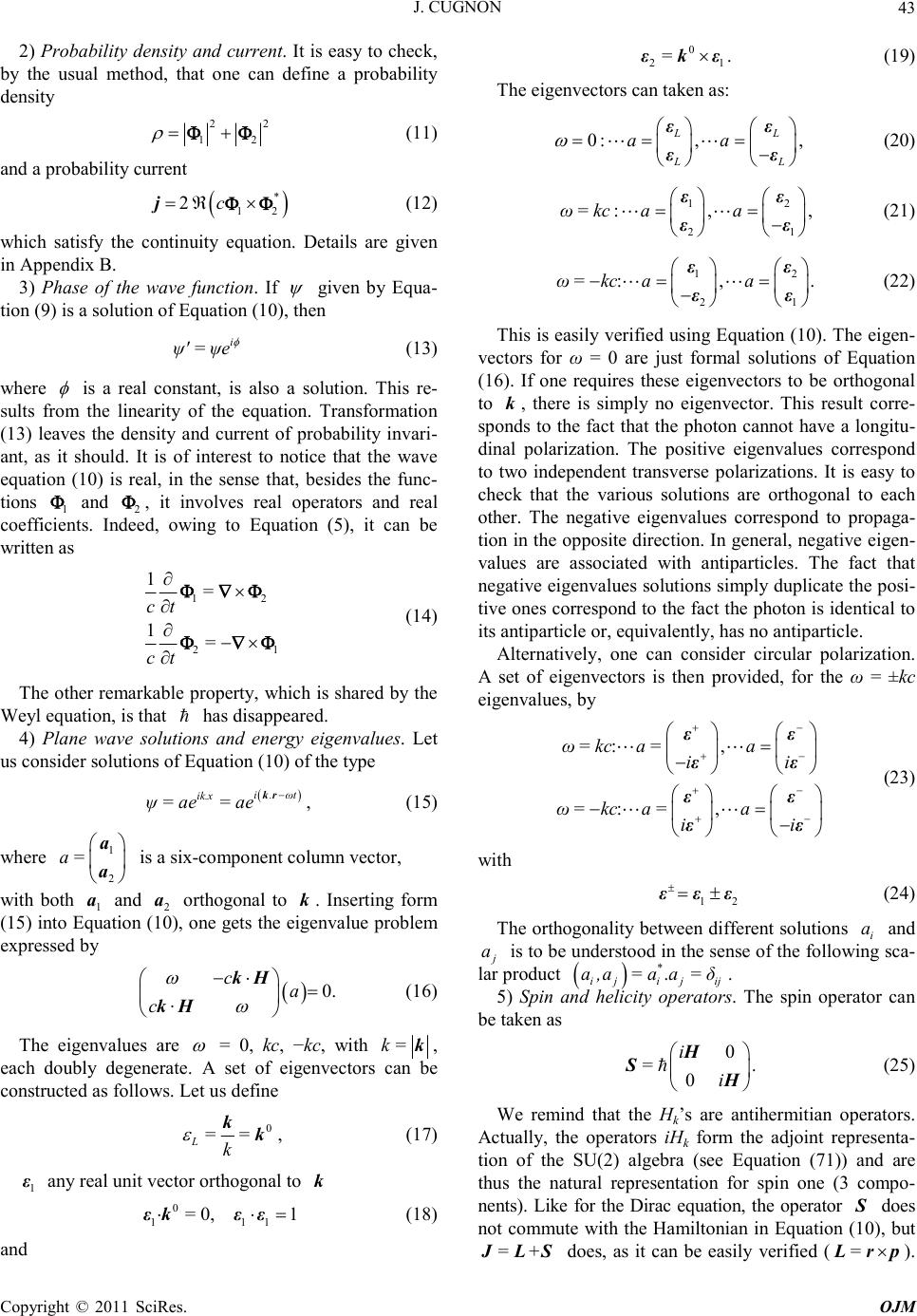 J. CUGNON43 2) Probability density and current. It is easy to check, by the usual method, that one can define a probability density 2 12 2 (11) and a probability current * 12 2 c j (12) which satisfy the continuity equation. Details are given in Appendix B. 3) Phase of the wave function. If given by Equa- tion (9) is a solution of Equation (10), then i ψ'=ψe (13) where is a real constant, is also a solution. This re- sults from the linearity of the equation. Transformation (13) leaves the density and current of probability invari- ant, as it should. It is of interest to notice that the wave equation (10) is real, in the sense that, besides the func- tions 1 and 2, it involves real operators and real coefficients. Indeed, owing to Equation (5), it can be written as 12 21 1 1 = ct = ct (14) The other remarkable property, which is shared by the Weyl equation, is that has disappeared. 4) Plane wave solutions and energy eigenvalues. Let us consider solutions of Equation (10) of the type i.ωt ik.x ψ=ae =aekr , (15) where is a six-component column vector, 1 2 a= a a with both 1 and 2 a orthogonal to . Inserting form (15) into Equation (10), one gets the eigenvalue problem expressed by a k 0. ca c kH kH (16) The eigenvalues are = 0, kc, −kc, with k=k, each doubly degenerate. A set of eigenvectors can be constructed as follows. Let us define 0 L== k kk, (17) 1 ε any real unit vector orthogonal to k 0 11 0, 1=εkεε 1 1 L 2 , 2 2 (18) and 0 2 =εkε. (19) The eigenvectors can taken as: 0: ,, L LL aa εε εε (20) 1 21 :,ω=kc aa εε εε (21) 1 21 :,ω=kc aa εε εε . (22) This is easily verified using Equation (10). The eigen- vectors for ω = 0 are just formal solutions of Equation (16). If one requires these eigenvectors to be orthogonal to , there is simply no eigenvector. This result corre- sponds to the fact that the photon cannot have a longitu- dinal polarization. The positive eigenvalues correspond to two independent transverse polarizations. It is easy to check that the various solutions are orthogonal to each other. The negative eigenvalues correspond to propaga- tion in the opposite direction. In general, negative eigen- values are associated with antiparticles. The fact that negative eigenvalues solutions simply duplicate the posi- tive ones correspond to the fact the photon is identical to its antiparticle or, equivalently, has no antiparticle. k Alternatively, one can consider circular polarization. A set of eigenvectors is then provided, for the ω = ±kc eigenvalues, by :, :, ω=kc a=a ii ω=kc a=a ii εε εε εε εε (23) with 1 εεε (24) The orthogonality between different solutions i and j is to be understood in the sense of the following sca- lar product a a *. ijij ij a,a=aa =δ. 5) Spin and helicity operators. The spin operator can be taken as 0. 0 i =i H SH (25) We remind that the Hk’s are antihermitian operators. Actually, the operators iHk form the adjoint representa- tion of the SU(2) algebra (see Equation (71)) and are thus the natural representation for spin one (3 compo- nents). Like for the Dirac equation, the operator does not commute with the Hamiltonian in Equation (10), but S =+ LS does, as it can be easily verified (= Lrp). Copyright © 2011 SciRes. OJM 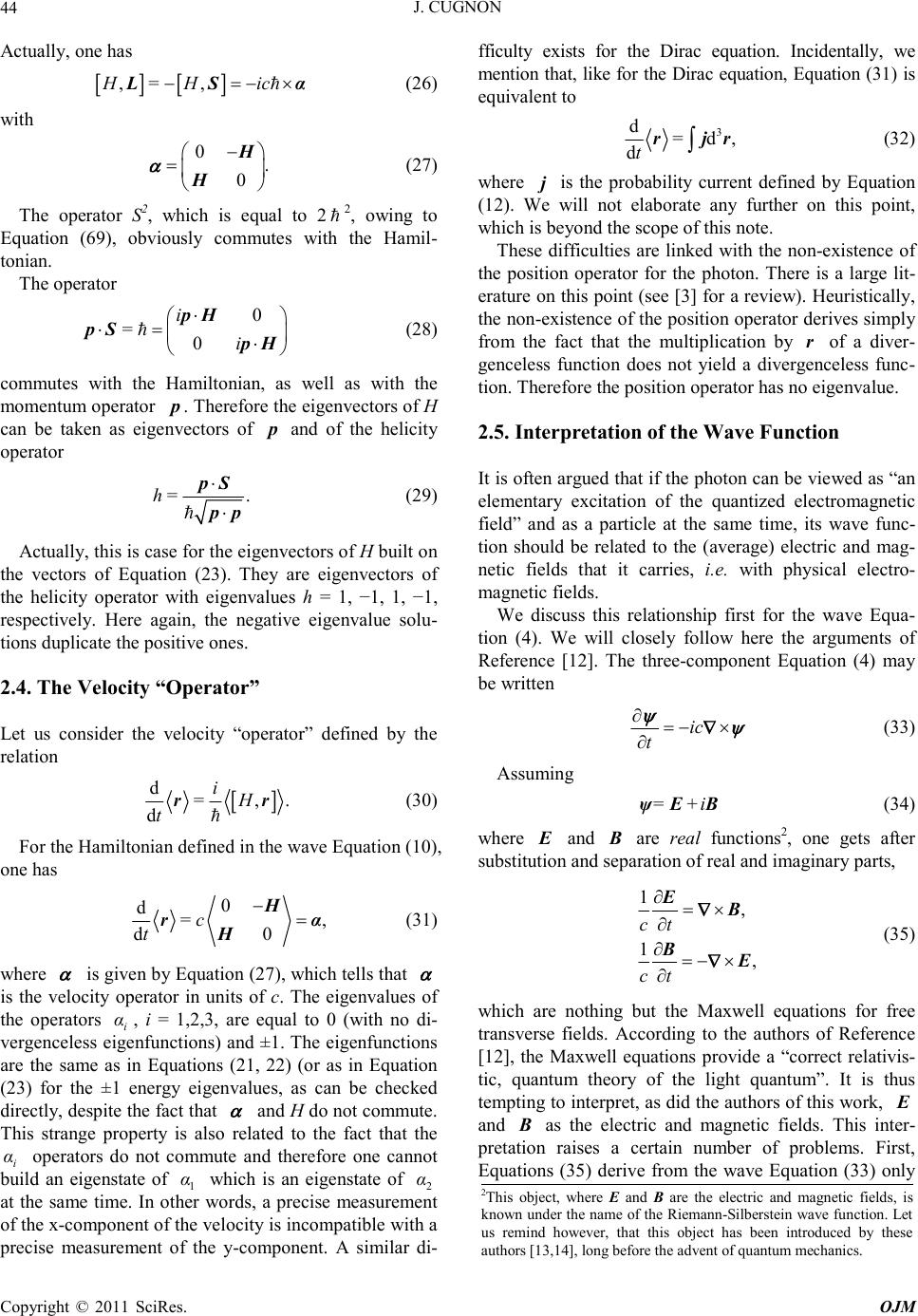 J. CUGNON 44 Actually, (26) with (27) The operator S2, which is equal to 2, owing to Eq rator one has ,H=L ,H icSα 0. 0 H H 2 uation (69), obviously commutes with the Hamil- tonian. The ope 0 0 i =i pH pS H (28) commutes with the Hamiltonian, as well as with the momentum operator . Therefore the eigenvectors of H can be taken as eigeectors of nv and of the helicity operator .h= S p (29) Actually, this is case for the eigenvectors of H built on th .4. The Velocity “Operator” et us consider the velocity “operator” defined by the e vectors of Equation (23). They are eigenvectors of the helicity operator with eigenvalues h = 1, −1, 1, −1, respectively. Here again, the negative eigenvalue solu- tions duplicate the positive ones. 2 L relation d,. d i =H t rr (30) For the Hamiltonian defined in the wave Equation (10), one has 0 d, 0 d=c t H rα H (31) where is given by Equation (27), which tells that ofis the vcity operator in units of c. The eigenvalues the operators i α, i = 1,2,3, are equal to 0 (with no di- vergenceless enfunctions) and ±1. The eigenfunctions are the same as in Equations (21, 22) (or as in Equation (23) for the ±1 energy eigenvalues, as can be checked directly, despite the fact that elo ige and H do not commute. This strange property is alsolated to the fact that the i α operators do not commute and therefore one cannot ild an eigenstate of 1 α which is an eigenstate of 2 α at the same time. In oth words, a precise measurem of the x-component of the velocity is incompatible with a precise measurement of the y-component. A similar di- fficulty exists for the Dirac equation. Incidentally, we mention that, like for the Dirac equation, Equation (31) is equivalent to re bu er ent 3 dd, d= t r r (32) where is the probability current defined by Equation on-existence of th e .5. Interp r e tation of the Wa ve Func t i on is often argued that if the photon can be viewed as “an relationship first for the wave Equa- tio (12). We will not elaborate any further on this point, which is beyond the scope of this note. These difficulties are linked with the n e position operator for the photon. There is a large lit- erature on this point (see [3] for a review). Heuristically, the non-existence of the position operator derives simply from the fact that the multiplication by r of a diver- genceless function does not yield a divergnceless func- tion. Therefore the position operator has no eigenvalue. 2 It elementary excitation of the quantized electromagnetic field” and as a particle at the same time, its wave func- tion should be related to the (average) electric and mag- netic fields that it carries, i.e. with physical electro- magnetic fields. We discuss this n (4). We will closely follow here the arguments of Reference [12]. The three-component Equation (4) may be written ic t (33) Assuming =+iψ B (34) where unct i ons2, one gets after and are rea l f tioepsubstitun and saration of real and imaginary parts, 1, 1, ct ct E B (35) which are nothing but the Maxwell equations for free transverse fields. According to the authors of Reference [12], the Maxwell equations provide a “correct relativis- tic, quantum theory of the light quantum”. It is thus tempting to interpret, as did the authors of this work, and as the electric and magnetic fields. This int pretan raises a certain number of problems. First, Equations (35) derive from the wave Equation (33) only er- tio 2This object, where E and Bare the electric and magnetic fields, is known under the name of the Riemann-Silberstein wave function. Let us remind however, that this object has been introduced by these authors [13,14], long before the advent of quantum mechanics. Copyright © 2011 SciRes. OJM 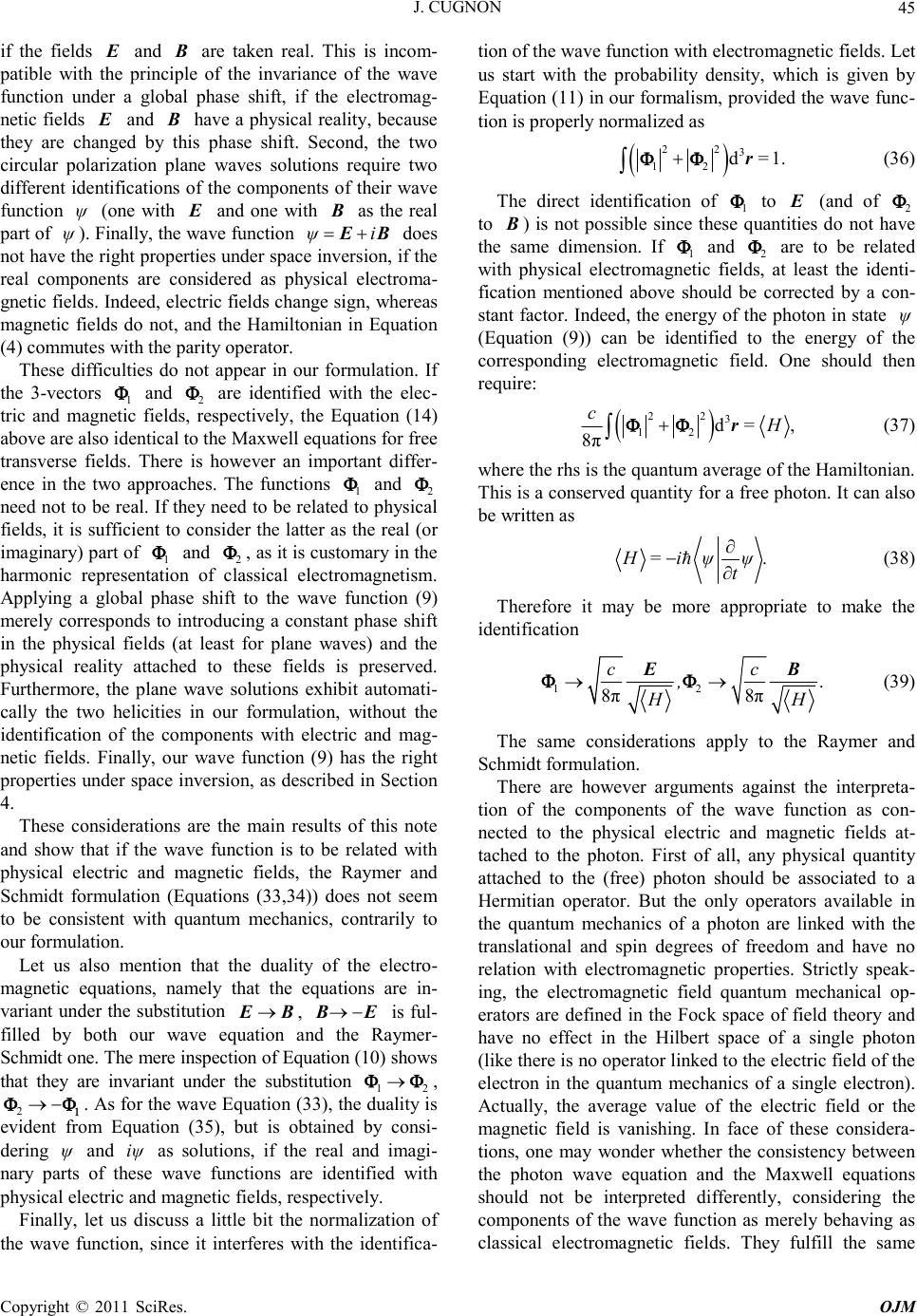 J. CUGNON45 if the fields and are taken real. This is incom- patible with th princie of the invariance of the wave function under a global phase shift, if the electromag- netic fields e pl and have a physical reality, because they are changed by this phase shift. Second, the two circular polarization plane waves solutions require two different identifications of the components of their wave function ψ (one with and one with as the real part of ψ Finally, the wve function ψi ). a B does not havee right properties under spac if the real components are considered as physical electroma- gnetic fields. Indeed, electric fields change sign, whereas magnetic fields do not, and the Hamiltonian in Equation (4) commutes with the parity operator. These difficulties do not appear in ou the irsion, r fulatio nve ormn. If the 3-vectors 1 and 2 are identified with the elec- tric and magnetic fieldsspectively, the Equation (14) above are also identical to the Maxwell equations for free transverse fields. There is however an important differ- ence in the two approaches. The functions 1 and 2 , re need not to be real. If they need to be related physi fields, it is sufficient to consider the latter as the real (or imaginary) part of 1 and 2 , as it is customary in the harmonic representn of ssical electromagnetism. Applying a global phase shift to the wave function (9) merely corresponds to introducing a constant phase shift in the physical fields (at least for plane waves) and the physical reality attached to these fields is preserved. Furthermore, the plane wave solutions exhibit automati- cally the two helicities in our formulation, without the identification of the components with electric and mag- netic fields. Finally, our wave function (9) has the right properties under space inversion, as described in Section 4. T lts of of t to resu this yhe electro cal at tio io s n th cla hesideratione main note an enat the dualit- m e cons are th d show that if the wave function is to be related with physical electric and magnetic fields, the Raymer and Schmidt formulation (Equations (33,34)) does not seem to be consistent with quantum mechanics, contrarily to our formulation. Let us also m agnetic equations, namely that the equations are in- variant under the substitution B, E is ful- filled by both our wave eqanaymer- Schmidt one. The mere inspection of Equation (10) shows that they are invariant under the substitution 12 uation de R th , 2 . As for the wave Equation (33), the s m Equation (35), but is obtained by consi- dering ψ and iψ as solutions, if the real and imagi- nary pa of th wave functions are identified with physical electric and magnetic fields, respectively. Finally, let us discuss a little bit the normalizati duality i evident fro rts ese on of the wave function, since it interferes with the identifica- tion of the wave function with electromagnetic fields. Let us start with the probability density, which is given by Equation (11) in our formalism, provided the wave func- tion is properly normalized as 2 2 3 12 d1.=r (36) The direct identification of to 1 (and of 2 to ) is not possible since these quantis do not ha theme dimension. If 1 tie ve sa and 2 are to be related with physical electromagnic fieldat least the identi- fication mentioned above should be corrected by a con- stant factor. Indeed, the energy of the photon in state ψ (Equation (9)) can be identified to the energy of t corresponding electromagnetic field. One should then require: ets, he 22 3 12 d, 8π c=H r (37) where the rhs is the quantum average of the Hamiltonian. This is a conserved quantity for a free photon. It can also be written as .H= iψψ t (38) Therefore it may be more appropriate to make the identification 12 . 8π8π cc , H EB (39) The same considerations apply to the Raymer and Sc arguments against the interpreta- tio hmidt formulation. There are however n of the components of the wave function as con- nected to the physical electric and magnetic fields at- tached to the photon. First of all, any physical quantity attached to the (free) photon should be associated to a Hermitian operator. But the only operators available in the quantum mechanics of a photon are linked with the translational and spin degrees of freedom and have no relation with electromagnetic properties. Strictly speak- ing, the electromagnetic field quantum mechanical op- erators are defined in the Fock space of field theory and have no effect in the Hilbert space of a single photon (like there is no operator linked to the electric field of the electron in the quantum mechanics of a single electron). Actually, the average value of the electric field or the magnetic field is vanishing. In face of these considera- tions, one may wonder whether the consistency between the photon wave equation and the Maxwell equations should not be interpreted differently, considering the components of the wave function as merely behaving as classical electromagnetic fields. They fulfill the same Copyright © 2011 SciRes. OJM 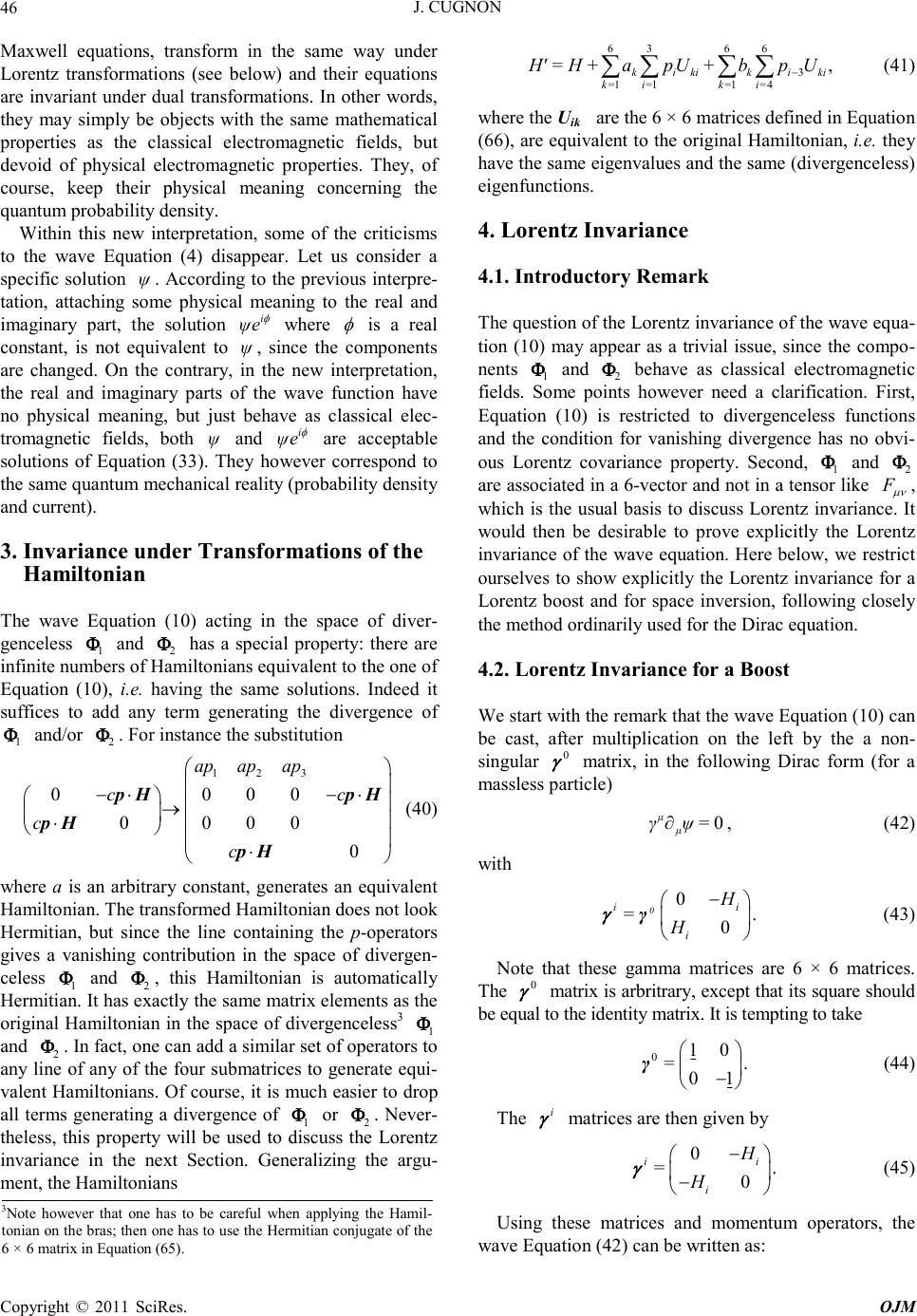 J. CUGNON 46 n, some of the criticisms to Maxwell equations, transform in the same way under Lorentz transformations (see below) and their equations are invariant under dual transformations. In other words, they may simply be objects with the same mathematical properties as the classical electromagnetic fields, but devoid of physical electromagnetic properties. They, of course, keep their physical meaning concerning the quantum probability density. Within this new interpretatio the wave Equation (4) disappear. Let us consider a specific solution ψ. According to the previous interpre- tation, attaching se physical meaning to the real and imaginary part, the solution i ψe om where is a real constant, is not equivalent to ince the components are changed. On the contrary, in the new interpretation, the real and imaginary parts of the wave function have no physical meaning, but just behave as classical elec- tromagnetic fields, both ψ and i ψe ψ, s are acceptable solutions of Equation (33).hey hoer correspond to the same quantum mechanical reality (probability density and current). Twev 3. Invariance under Transformations of the he wave Equation (10) acting in the space of diver- Hamiltonian T genceless 1 and 2 has a special property: there are infinite numrs of Hiltonians equivalent to the one of Equation (10), i.e. having the same solutions. Indeed it suffices to add any term generating the divergence of 1 and/or 2 . For instance the substitution 123 ap apap be am 0000 0000 0 cc c c Hp pH pH H (40) where a is an arbitrary constant, generates an equivalent Hamiltonian. The transformed Hamiltonian does not look Hermitian, but since the line containing the p-operators gives a vanishing contribution in the space of divergen- celess 1 and 2 , this Hamiltonian is automatically Hermit It has actly the same matrix elements as the original Hamiltonian in the space of divergenceless3 1 ian. ex and 2 . In fact, one can add a similar set of operators any l of any of the four submatrices to generate equi- valent Hamiltonians. Of course, it is much easier to drop all terms generating a divergence of 1 or 2 . Never- theless, this property will be used to diuss t Lorentz invariance in the next Section. Generalizing the argu- ment, the Hamiltonians 63 to ine sc he 66 3 11 14 , kiki kik k=i=k= i= i '=H+apU+bpU (41) where the Uik are the 6 × 6 matrices defined in Equation variance ariance of the wave equa- (66), are equivalent to the original Hamiltonian, i.e. they have the same eigenvalues and the same (divergenceless) eigenfunctions. . Lorentz In4 .1. Introductory Remark4 he question of the Lorentz invT tion (10) may appear as a trivial issue, since the compo- nents 1 and 2 behave as classical electromagnetic fields. Some pois however need a clarification. First, Equation (10) is restricted to divergenceless functions and the condition for vanishing divergence has no obvi- ous Lorentz covariance property. Second, 1 and 2 nt are associated in a 6-vector and not in a tenslike or , e. Iwhich is the usual basis to discuss Lorentz invarianct would then be desirable to prove explicitly the Lorentz invariance of the wave equation. Here below, we restrict ourselves to show explicitly the Lorentz invariance for a Lorentz boost and for space inversion, following closely the method ordinarily used for the Dirac equation. .2. Lorentz Invariance for a Boost 4 e start with the remark that the wave EquWation (10) can be cast, after multiplication on the left by the a non- singular 0 matrix, in the following Dirac form (for a massless particle) 0 μ μ γψ=, (42) with (43) Note that these gamma matrices are 6 × 6 matrices. Th 0. 0 0i i i H =H γ e 0 matrix is arbritrary, except that its square should be equal to the identity matrix. It is tempting to take 010 . 01 = γ (44) The i matrices are then given by (45) Using these matrices and momentum operators, the wave Equation (42) can be written as: 0H . 0 i i i =H 3Note however that one has to be careful when applying the Hamil- tonian on the bras; then one has to use the Hermitian conjugate of the 6 × 6 matrix in Equation (65). Copyright © 2011 SciRes. OJM  J. CUGNON47 01 02 10, 1 pc cp pH pH (46) which, with 0 =i,t is equivalen (10). The gamma matrices introduced here do not follow ommutation re t to Equation the same anticlations as the Dirac matrices. The reason is that the square of the operator in Equation (42) is not equal to p2, but to an operator which reduces to p2 for divergenceless functions. Presumably, the gamma matrices (43) are not unique and Equation (42) is, like the Dirac equation, independant of the representation. We did not investigate this point. We shall not attempt to derive the Lorentz invariance in general. Following the method described in Reference [15], we will verify this property for one particular transformation, namely a boost along the z axis. Ac- cording to this reference, it is sufficient to show that there exists a matrix S, relating the wave functions in the two different frames by S, which is such that if is a solution of Equation (42), is solution of the wave equation written in tormed frame: 0. μ u γψ'= (47) This equation may be rewritten as he transf 0, μν γaSψ= μν where (48) ν a e usu is the Lorentz transform ing thal method, it is thus su ist However, according to the discu Section, one must admit in th Eq where the dots stand for such terms, an giving vanishing contributions in the w ation matrix. Follow- fficient to show that there exs a matrix S satisfying . μν ν μ γa= γS (49) ssion of the preceding e right hand side of uation (48), additional terms, which give a vanishing contribution for divergenceless 1 and 2 , and the previous condition becomes μν ν μν ν γa=γS (50) + d any other terms ave equation. We merely show that the following matrix 3 3 1 1 = H H S (51) satisfies these requirements. In this equation, –β is the velocity of the primed frame with respect to the un- primed one. The corresponding Lorentz transformation matrix in Equation (50) is given by 00 0100 0010 = 00 a (52) We leave the detail of the calculat We collect the results for the operator of the lhs of Equation (48) from Equations (75-78): ion in Appendix C. 64 165266 3 31 132233 apSpUp UpUp Up UpUp 3 33035 1342 66062161 2 1 1 UpUp Up UpUpUp (53) where the 6 × 6 matrices Uab have all vanishing el except for the one at the crossing of line a and column b, which is equal to one. It is then very easy to see that the ements second and third terms of the rhs of the last equation gives vanishing contributions when applied to diver- genceless 1 and 2 . It can also easily be seen that the terms proportional to (γ − 1) are simply the z-com- ponents of the two Equations (14), giving thus also a vanishing ctributio One then recovers the Equations (46) or the Equations (14), except that the third and sixth equations are multiplied by (γ − 1). There is no secret beyond the matrix (51). It is nothing but the matrix expressing the transformation of classical transverse electromagnetic fields form one frame to the ot on n. her: ,S E B (54) see [16]. However, we consider here wave functions and thus we have to take care of some requirements. First, Equation (10) acts on divergenceless quantum mechanical functions. Therefore, one has to verify that this trans- formation preserves the vanishing divergence of the trans- formed components 1 and 2 . Once again, we limit the demonstration to the Lorentz boost described by Eq- uation (52). In this case, one has, with 111 123 ,, 1 2222 123 ,: 11 2131 123 11 211 31 123 3 1221 12 21 131 33 11 2131 123 12 222 213 )( t t t t 2 (55) In the second line, the explicit form of S (Equation Copyright © 2011 SciRes. OJM 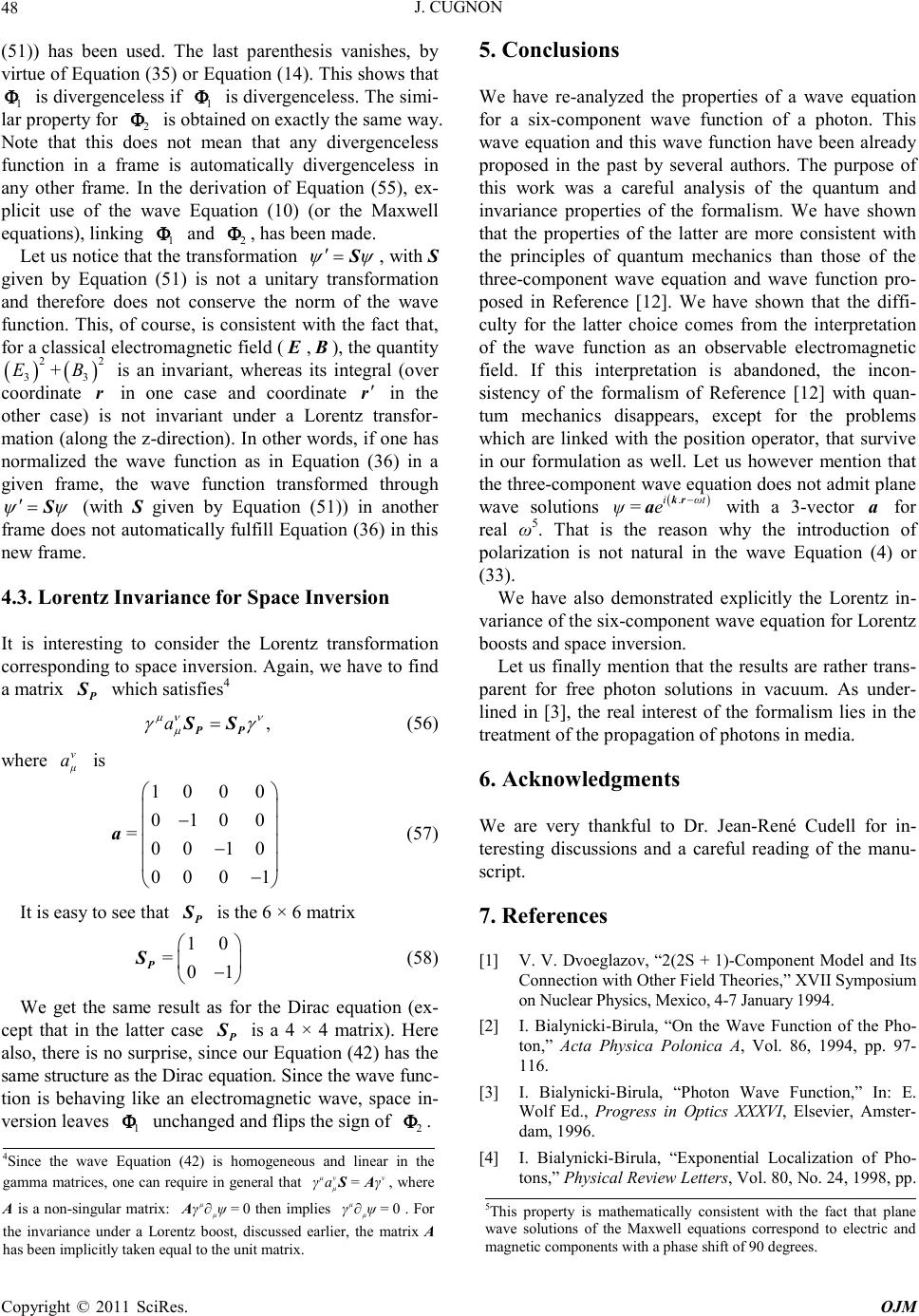 J. CUGNON 48 (51)) has been used. The last parenthesis vanishes, by virtue of Equation (35) or Equation (14). This shows that is divergenceless if is divergenceless. The simi- roperty for ised on exactly the same way. at this noan that any divergen tion in a f ismatically divergenceless in other framhvation of Equation (55), ex- licit use of thveation (10) (or the Maxwell tions), link 1 lar p Note th func any p equa 1 obtain t me auto e deri Equ and 2 does rame e. In t e wa ing celess 1 2 , has been made. Let us notice that the transformation S, with S given by Equation (51) is not a unitary transformation and therefore does not conserve the norm of the wave function. This, of course, is consistent with the fact that, for a classical electromagnetic field ( , ), the quantity 22 33 +B is an invariant, whereas its integral (over coordinate r in one case and coordinate r in the other case) is not invariant under a Lorentz transfor- mation (along the z-direction). In other words, if one has normalized the wave function as in Equation (36) in a givsformed en frame, the wave function tranthrough S (with S given by Equation (51)) in another frame does not automatically fulfill Equation (36) in this new frame. 4.3. Loren Invariance for Space Inversion It is interesting to consider the Lorentz transformation corresponding to space inversion. Again, we have to find a matrix tz S which satisfies4 ,a PP SS (56) where ν a is 1000 0100 00 10 = a 00 01 It is easy to see that (57) S is the 6 × 6 matrix 10 01 = P S etame result as for the Dirac equation (ex- cept that in the latter case (58) We g the s S ince o c equat electrom is a 4 × 4 matrix). Here also, there is no surprise, sur Equation (42) has the same structure as the Diraion. tion is behaving like anagnetic wave, space in- version leaves unchanged and flips the sign of Since the wave func- . 5. We have re-analyzed the prop for a six-component wave function of a photon. This w era f f t ve equation and wave function pro- We have shown that the diffi- ropagation of W ium co, 4-7 January 1994. the Wave Function of the Pho- olf Ed., Progress in Optics XXXVI, Elsevier, Amster- irula, “Exponential Localization of Pho- tons,” Physical Review Letters, Vol. 80, No. 24, 1998, pp. 1 2 Conclusions erties of a wave equation ave equation and this wave function have been already proposed in the past by sevl authors. The purpose of this work was a careful analysis of the quantum and invariance properties of the formalism. We have shown that the properties of the latter are more consistent with the principles oquantum mechanics than those ohe three-component wa osed in Reference [12]. p culty for the latter choice comes from the interpretation of the wave function as an observable electromagnetic field. If this interpretation is abandoned, the incon- sistency of the formalism of Reference [12] with quan- tum mechanics disappears, except for the problems which are linked with the position operator, that survive in our formulation as well. Let us however mention that the three-component wave equation does not admit plane wave solutions .iωt ψ= ekr a with a 3-vector a for real ω5. That is the reason why the introduction of polarization is not natural in the wave Equation (4) or (33). We have also demonstrated explicitly the Lorentz in- variance of the six-component wave equation for Lorentz boosts and space inversion. Let us finally mention that the results are rather trans- parent for free photon solutions in vacuum. As under- lined in [3], the real interest of the formalism lies in the treatment of the p photons in media. 6. Acknowledgments e are very thankful to Dr. Jean-René Cudell for in- teresting discussions and a careful reading of the manu- script. 7. References [1] V. V. Dvoeglazov, “2(2S + 1)-Component Model and Its Connection with Other Field Theories,” XVII Sympos on Nuclear Physics, Mexi 2] I. Bialynicki-Birula, “On [ ton,” Acta Physica Polonica A, Vol. 86, 1994, pp. 97- 116. [3] I. Bialynicki-Birula, “Photon Wave Function,” In: E. W dam, 1996. 4] I. Bialynicki-B[ 4Since the wave Equation (42) is homogeneous and linear in the gamma matrices, one can require in general that , where μν ν μ γa=γSA is a non-singular matrix: then implies . For the invariance under a Lorentz boost, discussed earlier, the matrix A has been implicitly taken equal to the unit matrix. 0 μ μ γψ=A0 μ μ γψ=5This pro erty is mathematically consistent with the fact that plane wave solutions of the Maxwell equations correspond to electric and magnetic components with a phase shift of 90 degrees. Copyright © 2011 SciRes. OJM  J. CUGNON Copyright © 2011 SciRes. OJM 49 5247-5250. doi :10. 1103 /Ph ysRev Lett. 80 .52 47 [5] J. E. Sipe, “Photon Wave Functions,” Physical Review A, Vol. 52, No. 3, 1995, pp. 1875-1883. do i:10. 1103 /P hysRev Lett. 80 .52 47 [6] D. H. Kobe, “A Relativistic Schrödinger-Like Equation for a Photon and Its Second Quantization,” Foundations of Physics, Vol. 29, No. 8, 1999, pp. 1203-1231. doi:10.1023/A:1018855630724 [7] M. Hawton, “Lorentz-Invariant Photon Number Density,” Physical Review A, Vol. 78, No. 1, 2008, Article ID 012111. doi:10.1103/PhysRevA.78.012111 [8] H. Feshbach and F. Villars, “Elementary Relativistic . 1, 1958, pp. 24- Wave Mechanics of Spin 0 and Spin 1/2 Particles,” Re- views of Modern Physics, Vol. 30, No 45. doi:10.1103/RevModPhys.30.24 [9] Z.-Y. Wang, C.-D. Xiong and O. Keller, “The First- Quantized Theory of Photons,” Chinese Physics Letters, Vol. 24, No. 2, 2007, pp. 418-420. doi:10.1088/0256-307X/24/2/032 ished Research Notes in, 2009. [10] Z.-Y. Wang, C.-D. Xiong and O. Keller, “Photon Wave Mechanics,” Chinese Physics Letters, Vol. 24, No. 2, 2007, arXiv:quant-ph/0511181v5. [11] S. Esposito, E. Recami, A. Van der Merwe and R. Battiston, “Ettore Majorana: Unpubl on Theoretical Physics,” Springer, Berl doi:10.1007/978-1-4020-9114-8 [12] M. G. Raymer and B. J. Smith, “The Maxwell Wave Function of the Photon,” SPIE Conference Optics and rtiellen ematischen Physik Nach rundgleichungen in Photonics, San Diego, August 2005. [13] H. Weber, “Notes on Differential Equations by Riemann,” In: Riemann and G. F. Berhard, Eds., Die Pa Differential-Gleichungen der Math Riemann’s Vorlesungen, Friedrich Vieweg und Sohn, Bruns- wick, 1901, p. 348. [14] L. Silberstein, “Elektromagnetische G Bivectorieller Behandlung,” Annalen der Physik, Vol. 22, 1907, p. 579. doi:10.1002/andp.19073270313 [15] J. J. Sakurai, “Advanced Quantum Mechanics,” Addison- Wesley Publication Co., London, 1967. [16] J. D. Jackson, “Classical Electrodynamics,” John Wiley, New York, 1975, pp. 552-554. 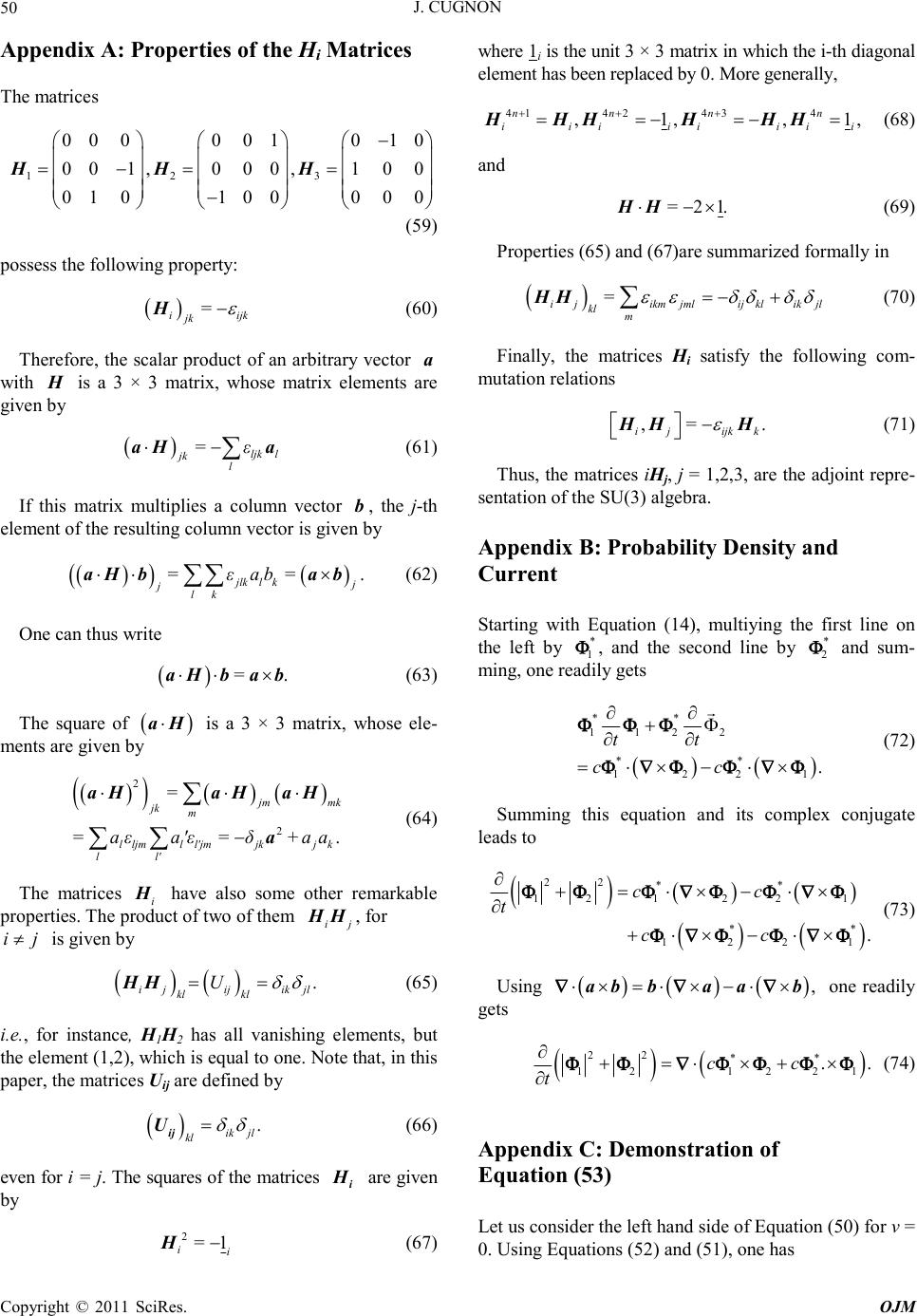 J. CUGNON 50 Appendix A: Properties of the Hi Matrices The matrices 123 00 00 01010 001,0 00,1 0 0 010100 000 HHH (59) possess the following property: i ijk jk = H (60) Therefore, the scalar product of an arbitrary vector with is a 3 × 3 matrix, whose matrix elements are given by a H ljk l jk l =ε aH a (61) If this matrix multiplies a column vector , the j-th element of the resulting column vector is given by b . jlkl kj jlk =εab= aHba b (62) One can thus write .=aHbab (63) The square of is a 3 × 3 matrix, whose ele- ments are given by aH 2 2. jm mk jk m l ljmll'jmjkjk ll' = =aεa'ε=δ+a a aHaH aH a (64) The matrices i have also some other remarkable properties. The product of two of them , for is given by H ij HH ij . ijijik jl kl kl U HH (65) i.e., for instance, H1H2 has all vanishing elements, but the element (1,2), which is equal to one. Note that, in this paper, the matrices Uij are defined by . ik jl kl ij U (66) even for i = j. The squares of the matrices are given by i H 21 ii =H (67) where 1i is the unit 3 × 3 matrix in which the i-th diagonal element has been replaced by 0. More generally, 414 24 34 ,1, , nn nn ii iiii ii 1, HHHHHH (68) and 21.= HH (69) Properties (65) and (67)are summarized formally in ijikmjmlij klikjl kl m = HH (70) Finally, the matrices Hi satisfy the following com- mutation relations , ijijk k = HH H. (71) Thus, the matrices iHj, j = 1,2,3, are the adjoint repre- sentation of the SU(3) algebra. Appendix B: Probability Density and Current Starting with Equation (14), multiying the first line on the left by * 1 , and the second line by and sum- ming, one readily gets * 2 ** 112 2 ** 122 . tt cc 1 (72) Summing this equation and its complex conjugate leads to 22 ** 12 122 1 ** 122 . cc t cc 1 (73) Using , abba ab one readily gets 22 ** 12 1221 ..cc t (74) Appendix C: Demonstration of Equation (53) Let us consider the left hand side of Equation (50) for ν = 0. Using Equations (52) and (51), one has Copyright © 2011 SciRes. OJM 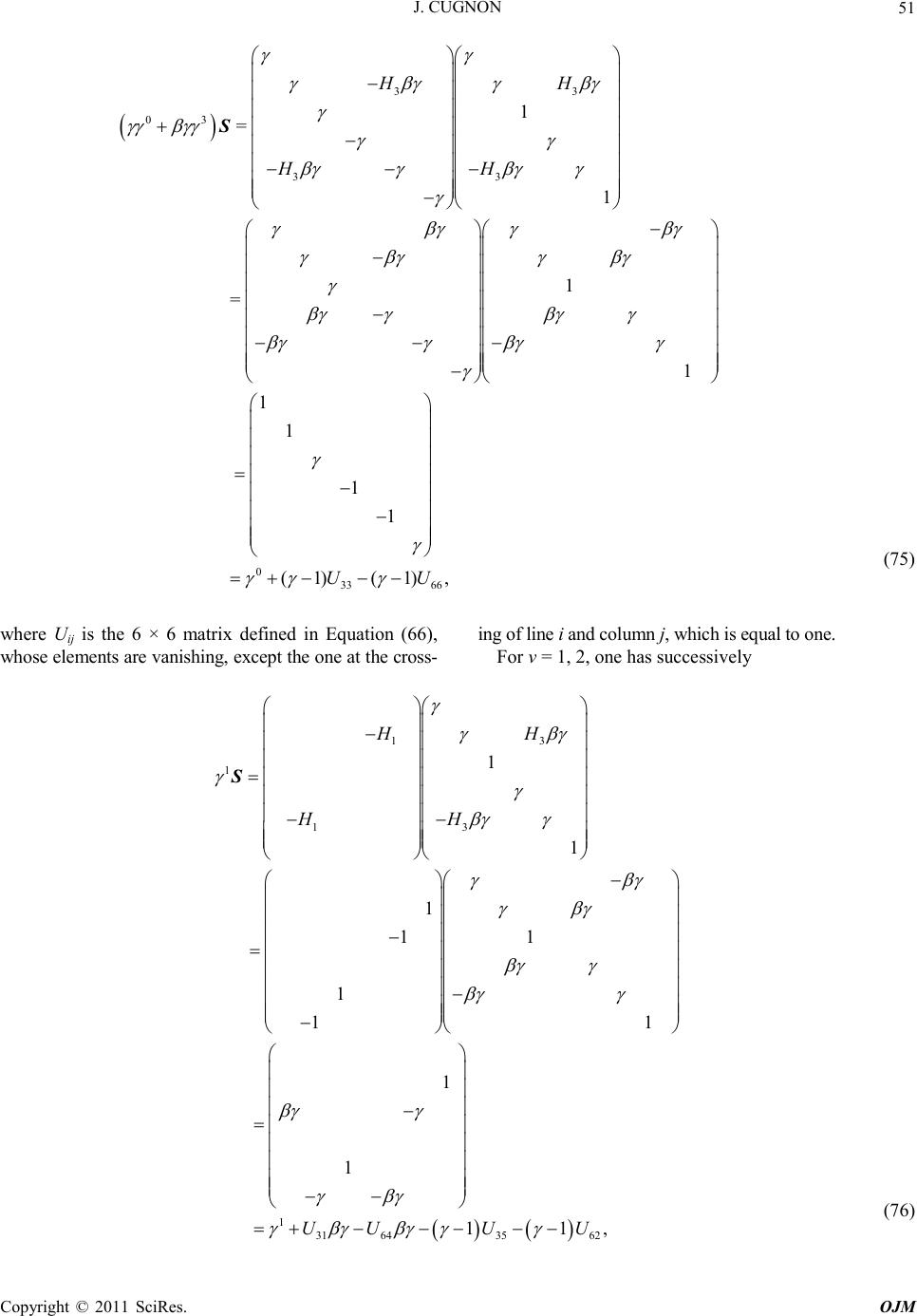 J. CUGNON Copyright © 2011 SciRes. OJM 51 33 03 33 1 1 1 1 HH = HH = S 0 33 66 1 1 1 1 (1)(1),UU (75) where Uij is the 6 × 6 matrix defined in Equation (66), whose elements are vanishing, except the one at the cross- ing of line i and column j, which is equal to one. For ν = 1, 2, one has successively 13 1 13 1 31 64 1 1 1 11 1 11 1 1 1 HH HH UU S 35 62 1,UU (76)  J. CUGNON 52 23 2 23 2 32 653461 1 1 1 11 1 11 1 11. 1 HH HH UUU U S (77) Finally, one has, for ν = 3, 33 03 33 1 1 1 1 HH HH S 3 33 66 1 1 . 1 1 UU (78) Copyright © 2011 SciRes. OJM
|